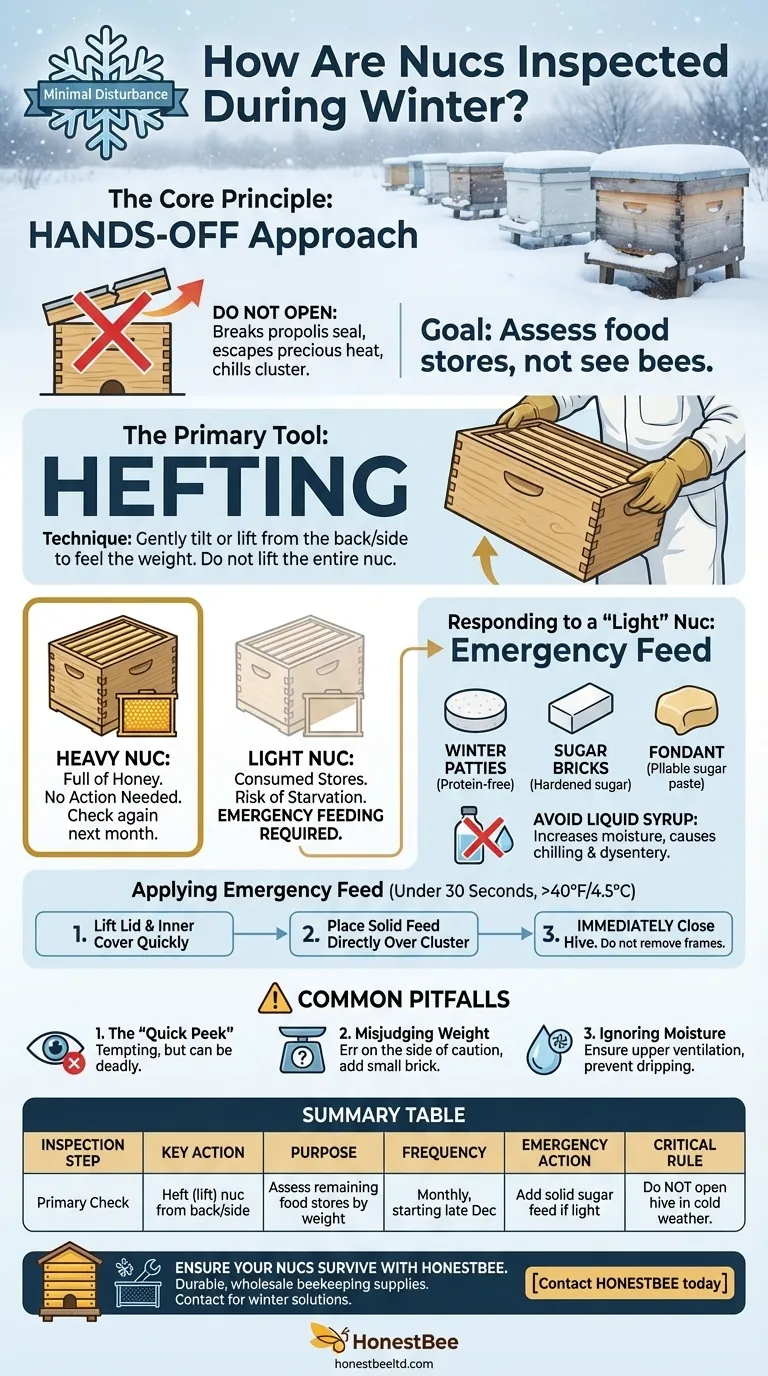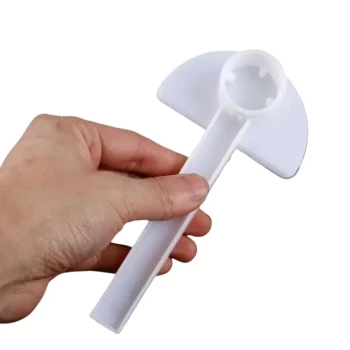Winter nuc inspections are fundamentally different from those in other seasons. They are performed without opening the hive to avoid chilling the colony. The primary technique is to check the nuc's weight by tilting or lifting it from one side to assess the remaining food stores, a process often referred to as "hefting."
The core principle of winter nuc care is minimal disturbance. Your goal is not to see the bees, but to assess their food supply by feeling the nuc's weight. This single action, performed monthly, is the key to deciding if emergency feeding is necessary to ensure their survival.

The "Hands-Off" Approach to Winter Inspections
During winter, the bee cluster's survival depends on maintaining a stable internal temperature and conserving energy. A traditional, invasive inspection can be a death sentence.
Why You Must Not Open the Nuc
Opening a hive in cold weather breaks the colony's propolis seal, which they use to block drafts. This allows precious heat to escape, forcing the bees to burn through their honey stores much faster to re-warm the cluster. A sudden blast of cold air can also chill the bees and any potential brood, causing significant stress.
The "Hefting" Method: Your Primary Tool
The safest way to check a nuc is by hefting. Starting the week after Christmas, and repeating monthly, gently lift the nuc from the back or one side. Your goal is to get a feel for its weight.
A heavy nuc is full of honey and requires no action. A surprisingly light nuc indicates that the bees have consumed most of their stores and are at risk of starvation.
Establishing a Baseline Weight
The best way to judge weight is by comparison. In the late fall, after the nuc has been fully provisioned for winter, heft it to memorize the feel of a "full" nuc. This memory becomes your baseline for all future winter checks.
Responding to a "Light" Nuc
If you heft a nuc and it feels dangerously light, you must provide emergency food. This is a targeted intervention to prevent starvation.
The Need for Emergency Feed
This is not a routine feeding. It is an emergency measure taken only when hefting indicates a critical lack of food. Adding feed when it's not needed is an unnecessary disturbance.
What to Feed in an Emergency
The best emergency winter feeds are solid forms of sugar that do not add moisture to the hive. Excellent options include:
- Winter Patties: Commercially available, protein-free sugar patties.
- Sugar Bricks: Homemade blocks of hardened sugar.
- Fondant: A soft, pliable sugar paste used by bakers and beekeepers.
Avoid feeding liquid syrup, as it can increase hive moisture, chill the bees, and cause dysentery.
How to Apply Feed with Minimal Disturbance
Your goal is to be in and out of the hive in under 30 seconds. On a milder, calm day (above 40°F / 4.5°C if possible), quickly lift the lid and inner cover, place the sugar patty or brick directly on the top bars above the cluster, and immediately close the hive. Do not remove any frames or attempt to look for the queen.
Understanding the Common Pitfalls
Winter management is a delicate balance. Knowing what not to do is as important as knowing what to do.
The Danger of a "Quick Peek"
It is incredibly tempting to take a quick look inside, especially for new beekeepers. You must resist this urge. Even a brief peek on a cold day can undo the bees' hard work of sealing drafts and regulating their temperature. Trust the hefting method.
Misjudging the Nuc's Weight
Hefting is a skill that develops with experience. A beginner might have trouble judging the weight. If you are uncertain, it is always safer to err on the side of caution. A small sugar brick placed as insurance is far less risky than allowing a colony to starve.
Ignoring Moisture and Ventilation
While your primary inspection is for food, a quick glance when adding feed is useful. Look for signs of excessive moisture condensation on the inner cover. Proper upper ventilation is critical for letting moist air escape, preventing it from dripping onto the cluster.
Making the Right Choice for Survival
Your actions should be dictated entirely by the nuc's weight. Use this simple guide to make the correct decision each month.
- If your nuc feels heavy and dense: Your job is done. Leave the colony alone and check again in a month, ensuring the entrance is clear of snow and debris.
- If your nuc feels noticeably lighter than last month: It is time to provide an emergency solid feed. Place a sugar brick or winter patty directly over the cluster with minimal disturbance.
- If you are genuinely unsure about the weight: It is safer to add a small sugar brick as an insurance policy than it is to risk the colony starving before your next check.
Trusting these minimalist and non-invasive techniques is the most effective way to guide your colony safely through the winter and into spring.
Summary Table:
| Inspection Step | Key Action | Purpose |
|---|---|---|
| Primary Check | Heft (lift) the nuc from the back/side. | Assess remaining food stores by weight. |
| Frequency | Perform monthly, starting late December. | Monitor food consumption without disturbance. |
| Emergency Action | Add solid sugar feed (brick, patty, fondant) if light. | Prevent starvation; avoid liquid syrup. |
| Critical Rule | Do not open the hive in cold weather. | Preserve hive temperature and bee cluster. |
Ensure your nucs survive the winter with the right equipment. HONESTBEE supplies commercial apiaries and beekeeping equipment distributors with durable, wholesale-focused supplies—from nuc boxes to winter feeding essentials. Let our experts help you prepare your operation for the cold months. Contact HONESTBEE today for reliable beekeeping solutions.
Visual Guide

Related Products
- 5 Frame Wooden Nuc Box for Beekeeping
- Plastic Transporting Bee Packages and Nuc Boxes for Beekeeping
- Portable Bee Mating Hive Boxes Mini Mating Nucs 8 Frames for Queen Rearing
- 5 Frame Langstroth Poly Nuc Corrugated Plastic Nuc Boxes
- HONESTBEE Advanced Ergonomic Stainless Steel Hive Tool for Beekeeping
People Also Ask
- How should the nuc be installed in the apiary? Ensure Colony Success from Day One
- What is the most common type of standard nuc? The 5-Frame Nuc Explained
- What are the benefits of starting a new bee colony in a nuc box? Boost Colony Success with Efficient Beekeeping
- What is the purpose of having a nuc in beekeeping? Build a Resilient & Productive Apiary
- How many frames does a typical wooden nuc box hold? A Guide to Choosing the Right Size



















